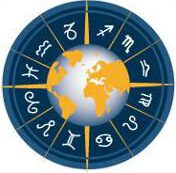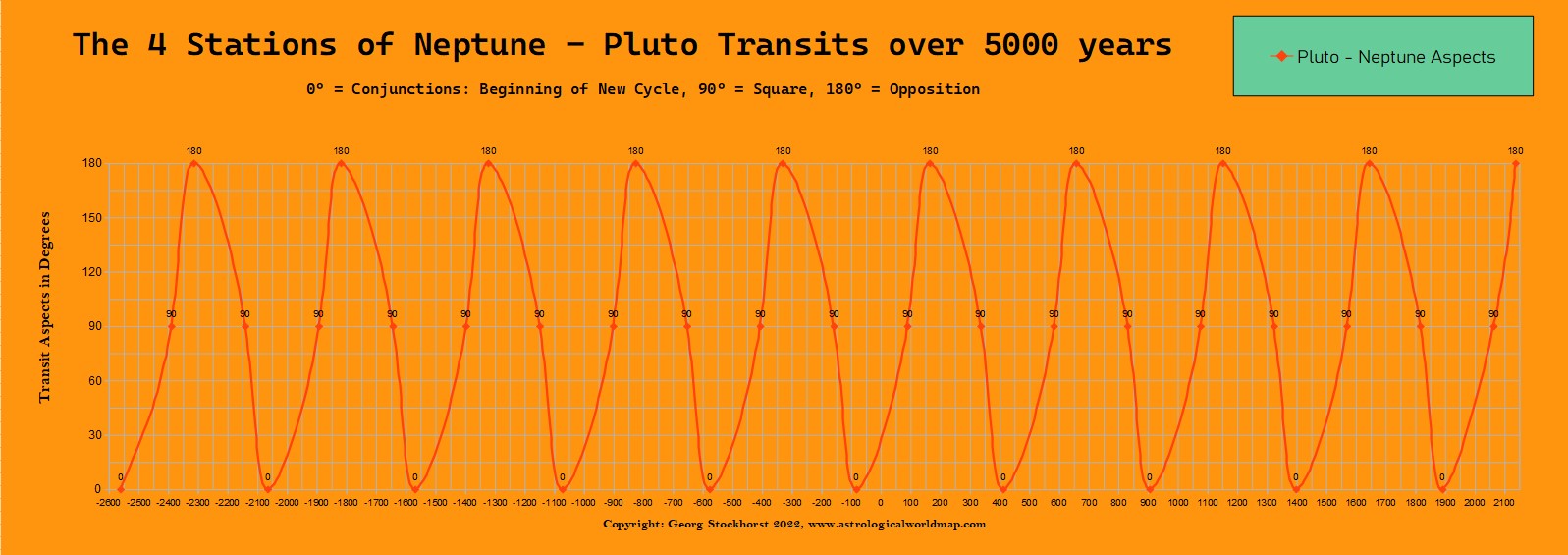Pluto-Neptune Cycles & Ages in Mundane Astrology. Some thoughts on the astrological interpretation of the time structure of Pluto-Neptune cycles.
Cornerstone articles: Pluto Transits in Political Astrogeography
Related articles: The Times of Jesus Christ in Astrology, The Wedding Feast at Cana in Astrology, Die Saturn – Pluto Konjunktion 2020, The first Pluto Return from the foundation of the USA, The Discovery of the planet Neptune, Die Jupiter – Neptun Konjunktion am 12. April 2022, Der Pluto Ingress in den Wassermann am 23.3.2023 und das Zeitalter des Klimawandels, On the competition between Poseidon and Zeus or Neptune and Jupiter, Wann beginnt das Wassermannzeitalter ?, Der Neptun Transit in Konjunktion mit Brüssel 2020-23,
I`m currently working on this article – please drop by to see how it progresses after a month or two!!!
Pluto-Neptune Transits in Mundane Astrology
Systemical astrological definitions of Ages
- Pluto – Neptune Cycles & Super-Cycles – duration: ca. 33.000 terrestrial years
- Pluto – Neptune Conjunctions-Cykles – duration: 495 terrestrial years
- Pluto Years – duration: 248 terrestrial years
- Uranus – Neptune Conjunctions-Cycles – duration: 171/172 terrestrial years
- Great Conjunctions of Saturn & Jupiter Cycles – duration: 119 – 238 terrestrial years
- Neptune Years – duration: 164 terrestrial years
- Uranus – Pluto Konjunktions Cycles – duration: 111-143 terrestrial years
- Uranus Years – Duration – duration: 84 terrestrial years
- Uranus – Saturn Conjunktions Cycles – duration: 44-48 terrestrial years
Systemical types of ages frequently used for occultist purposes:
- “Age of Pisces (ca. 0 CE – ca. 1400 or 2150 CE) & “Age of Aquarius” (ca. 1400 or 2150 CE to ca. 3300 CE) as Ages of Spring Equinox positions in sidereal positions of the year 0 – duration: 480 to 3200 terrestrial years or by 12 – sector sidereal zodiac definition ca. 2150 terrestrial years
Why use the Pluto and Neptune transits as most important factors for defining ages?
- they are high valuable for systemical interpretation because they have been extensively explored and tested as planetary rulers of zodiac signs meaning that the are part of the group that I call “SYSTEMICAL PLANETS”
- their conjunctions take place every ca. 495 years delivering a precise definition of the beginning and end of a period.
- in comparison to the extreme imprecision, occultism and mental manipulation applied to the precessional ages for example the precessional age of Aquarius whose potential start has been theoretically discussed as between ca. 1750 and 2300 CE) the Pluto-Neptune cycle delivers exact data.
- the position of their conjunction steadily progress through the 12 zodiac signs so that they make a full cycle aka a “PLUTO-NEPTUNE YEAR” of ca 33.000 years.
- The transit cycles between Neptune and Pluto stand for the development of the relationship between spiritual essence, origin and content and mental form, projection and materialization.
Easy keys to practical definitions for “Astrological Ages” using Pluto-Neptune conjunction cycles
I — Differentiation is the way to exploring astrogeography, systemical scientific methods of interpretation. religion and history too in depth. Using the 12 “systemical planets system” in transit astrology can deliver abstract, holistic because systemical approaches to exploring how long-term processes like the speeding up from industrial evolution to revolution can be explored from the point of view of systemical definitions.
II — The 1st Pluto-Neptune conjunction in Gemini of 30 Jun 1398 and with the bookprint revolution that followed it can serve as a solid definiton for the 1st stage of the first age of technological & industrial revolutions (from 1398 to 1891) of the 4434 years “PLUTO-NEPTUNE-IN-GEMINI- AGE”. This age contains 9 Pluto-Neptune cycles and conjunctions that progress frorward in steps of 5° to 2° degrees through the 30° of the sign of Gemini.
III — Synodic cycle definitions between PL-& NE can be used to explore how the bookprint revolution step did unfold until the “AGE OF MODERN SCIENCE” PL-NE Cj. in GEM AGE Pt. 2 from 1891 to 2385) took over triggered by the 2nd “PL-NE cj. in Gemini Revolution” on 2 Aug 1891.
IV — Consequences of the current age can be seen in the automation, car, airplane, rocket,, nuclear, United Nations, space, robot, digital, climate catastrophy, terrestrial parliament & government, migration into the galaxy and other revolutions.
The Potential of “Non-Systemical” Transneptunian Planets
Apart from the important role of the systemical planets (planets of rulership of a sign) Neptune and Pluto for systemical and holistic astrological interpretation the other Transneptunian dwarf planets, esp. Eris, Makemake and Haumea can surely play an important role in the observation and differentiation of different layers of historical processes too.
They deliver large amounts of data thus extending the quantity of possible considerations. But like in every field of study it is the in-depth aka the qualitative dimension of exploration of their meaning and circumstances that really matters.
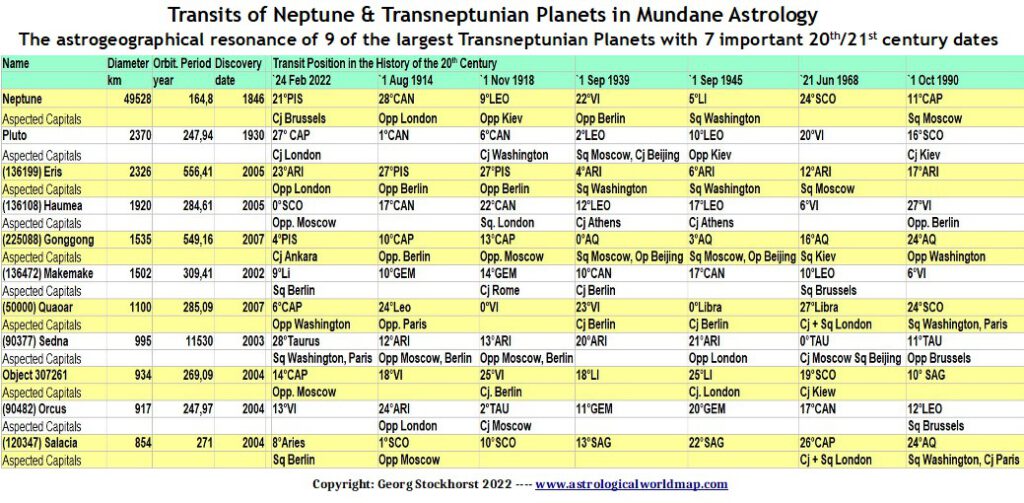
- the intensity of the resonance between the transit positions of the dwarf planets and the astrogeographical positions of the representative capitals of the national governments involved in these historical developments is breathtaking.
- ……….
Level I: The “Pluto-Neptune-Year” in Astrology
The cycle of conjunctions of the two outer planets Neptune and Pluto delivers the most important astrological transit aspect regarding the evaluation of longer historical periods (ages) of cultural, political and other mundane developments. At least among the 11 systemical planets that I am used to considering for birth chart interpretation for the 12-fold structural model of signs and houses used for holistic chart interpretation.

This is because their YEARS aka paths around the center of our solar ecosystem take far longer than those of the other 11 systemical planets.
Thus providing Pluto and Neptune with the role as key representatives of insights into the holistic, abstract and systemical dimensions and longer-term level of the significance of the climax events of long-term historical processes.
Important Basics on Neptune-Pluto conjunction cycles every astrologers should be aware of

- Pluto – Neptune conjunctions occur every nearly 500 years (exactly 492-496 years).
- The positions of Neptune-Pluto conjunctions progress forward trough the zodiac.
- that allows conclusions using their steady progress as a description of progressing development in time structure.
- the progress of a Neptune-Pluto conjunctions cycle through the 12 zodiac signs takes appr. 33.000 (+ 500) earth years: Unfortunately I have no exact data to offer telling us how long a full circle of Neptune -Pluto conjunctions lasts.
- every time the conjunction first occurs in Aries a new “Neptune-Pluto Year” year is fully activated in the sense of an astrological sign or house rulership.
- Relative to the degrees passed from 0°00 Aries to the exact degree position of the new conjunction in Aries the time span before the exact conjunction may be considered as part of a “buffer time span” at the beginning of the 33.000 earth years long new Pluto-Neptune-Year.
- for example: the current Neptune year began with the Pluto-Neptune conjunction of 2561 BC. Since the position of the conjunction event was at 1°31 Aries – which equals approximately 136 years meaning that the buffer period before full activation of the new period began around 2697 BC
- during the progress of the Neptune-Pluto conjunctions through the 6 signs from Scorpio to Aries they make only 3 conjunctions in each sign – except for Pisces where there are only two conjunctions.
- Taurus makes an exception because it is the only sign that sees 5 consecutive Pluto-Neptune conjunctions.
- the signs between Gemini and Libra see 9 or possibly in very rare cases even 10 conjunctions during one 33.000 Pluto-Neptune years though I assume that the average for these signs would be 9 conjunctions during one NE-PL Year.
The Current Neptune-Pluto Year from 2561 BC to ca. 30.500 CE as the age of “Civilization”

A full year of Neptune-Pluto conjunctions starts every time the position of their conjunction moves from Pisces into Aries which last happened on 8 May 2561 BC when the conjunction occurred at 1°31` Aries.
- The Pluto-Neptune Conjunction of 8 May 2561 BCE has therefore to be examined as a description of a major turning point in human history and culture.
- Horoscopes calculated for this conjunction at different places on earth can be understood as RADIX-CHARTS for the contemporary age.
- This conjunction happened to occur just 1° off the degree of the spring equinox (0°Aries). It so started a new 33.000 earth years long “Pluto-Neptune Year” in which the Pluto-Neptune conjunctions progresses through the 12 zodiac signs.
- particularly the development of urban settlements, urban culture, urban language, and the use of script from around 3500 BCE can be investigated as essential elements that accompanied the beginning of the current 33.000 years period. See also: List of oldest documents.
- the date also coincides with the initial period (since 3000 BC) of what sociology has defined as the first (known) development of “CIVILIZATION” on our planet. The term “civilization” is understood as: “any complex society characterized by the development of a political state, social stratification, urbanization, and symbolic systems of communication beyond natural spoken language (namely, a writing system)” (source: wikipedia article)
- The region where civilization was first developed was the so called “Fertile Crescent“. Its location is between the modern states of Lebanon, Syria, Palestine and Eastern Turkey in the West and Irak and parts of Southern Iran in the East. This fertile region served as a bridge between the African, Asian and European continents.
- the chart can be observed as the initial or foundation chart of a ca. 33.000 earth years long Pluto/Neptune year and of a 1444 earth years long Pluto/Neptune month under the rulership of the conjunction of Pluto and Neptune in Aries.
Interpretation of the Birth Chart of the “PL-NE Age of Civilization”
- The position of the Pluto-Neptune conjunction on the 1st degree of Aries and of the whole zodiac, explains how and under which overall planetary circumstances a new 33.000 years cycle of progress of development regarding the relationship between the formless essence and timeless purposes of subtle matter, cosmic conscience and the cosmic morphic field as such (Neptune) and the visible, mentally perceivable form of hard matter (Pluto) was initiated.
- Astrologically speaking the NE-PL conjunction of 8 May 2561 BCE triggered a new dimension in the exchange between the astrological representative of the holistic, long-term, ever-lasting, cosmic purposes of human life on earth (NEPTUNE) and the creation of new prime-examples, tools, habitats, dwellings, works, images and of patterns of interpretation of perceived experience (PLUTO) of trauma and relief, belief systems and of hierarchies.
- The position at 1° Aries has to be examined as a hint at the beginning of a new process in the mobilization in the fight for survival involving all 12 structural levels of human experience and learning.
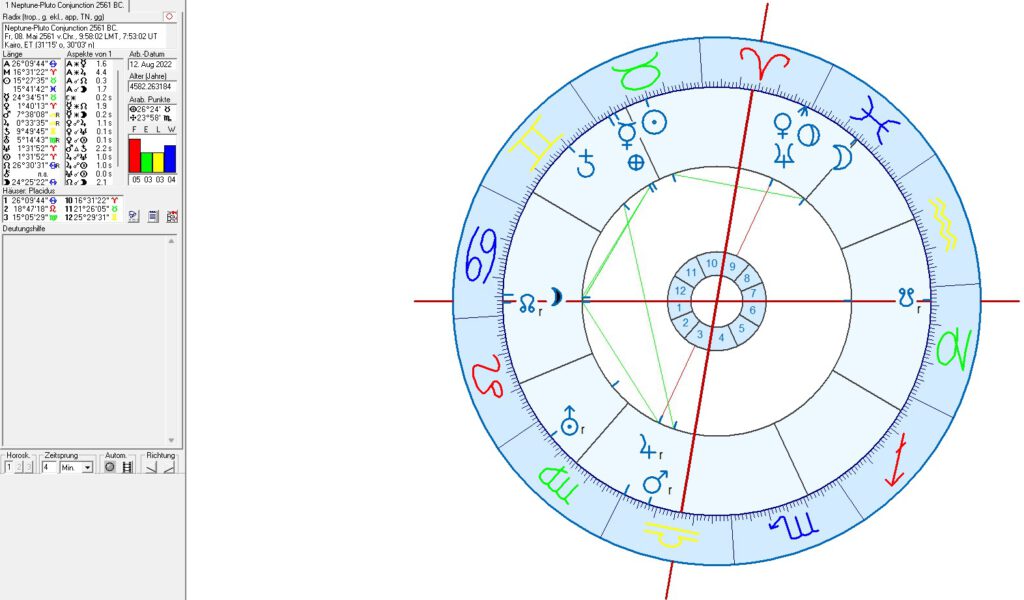
- the most remarkable planetary constellation in the chart involves a breathtakingly precise conjunction of the Pluto-Neptune stellium at 1°31 Aries with Venus at 1°40 Aries (spring equinox, beginning of the zodiac) being exactly opposed by Jupiter at 0°33 Libra (autumn equinox, exact mid-point of the zodiac) and Mars at 7°38 Libra.
- In regard to her role as the sign ruler of TAURUS the strong influence of Venus on the Neptune-Pluto conjunction stands for the beginning of a new era of agriculture, growing of wheat and grains, possession of cattle herds, food production as such, income, profits, settling down, growing roots, stabilization of market places, town centers and of societies through the prolongation of the possession of territory and resources with the effect of the creation of larger social groups, territorial empires and the development of nations.
- anyway Venuses position on the first degree of Aries clearly reflects the beginning of an era of stabilization of food production, wealth and economical growth as the basis for the “Age of Civilization”
- the complementary exchange and reception between the two sign rulers Mars (action) in Libra (sign of reception) and Venus (foundation (Taurus aspect), reception (Libra aspect)) in Aries (sign of action) is indicated through an opposition with each of the two planets placed in the sign of ruler-ship of the “opponent”.
- since air sign LIBRA (7th of 12 stages in the structural model of the zodiac) represents the sign of the development and ideals of social togetherness, empathy and relationship the position of Jupiter as the ruler of Sagittarius (thinking, concluding, understanding, explanations, mental knowledge) on the first degree of Libra can be examined as the astrological description of how a new level of cultural development was to be the major outcome of the new 33.000 years period.
- regarding the question about the PLANETARY ASTROLOGICAL INDICATOR OF CIVILIZATION AS SUCH it is the position of JUPITER (Zeus) as indicator of independent thinking, conclusions, explanations, success, luxury and growth at 0°33 Libra right on the mid-point of the zodiac aka the half-sum between its beginning and its end that appears to mark the qualities delivered by the development of civilization.
- this point of the chart interpretation delivers an opportunity for a deeper contemplation of the question: which aspects of Jupiter make his important role in the foundation process of civilization ?????
- My conclusion on the qualities that explain Jupiters role here was: it is Jupiter that stands for the capacity of independent recapitulation of stored memory, experience and knowledge along with the insights and conclusions therefrom allowing the visualization of solutions, of aims, of successful reality and of fulfillment of plans.
- and WHY LIBRA?
- Libra represents the opposite sign aka the potential for self-reflection of Aries` role as the astrological definition as the first, initial and basic momentum of all life, development and processes.
- Libra opposes the Aries assumption that the survival of the strongest by fighting is the most effective and successful strategy for survival. The possibility for Aries to reflect itself allowing a wider set of possibilities such as: A— friend, neighbor, trade, victim, partner and love relationships B —- empathy of communication and contacts, peace treaties, systems of alliances, negotiations, the development of rules for an equilibrium between violations and injuries suffered by each side, developments of what was to become courts and jurisdiction C—- exchange and trade of female partners between tribes to replace the robbing and raping methods needed to renew the genetic pools of local groups.
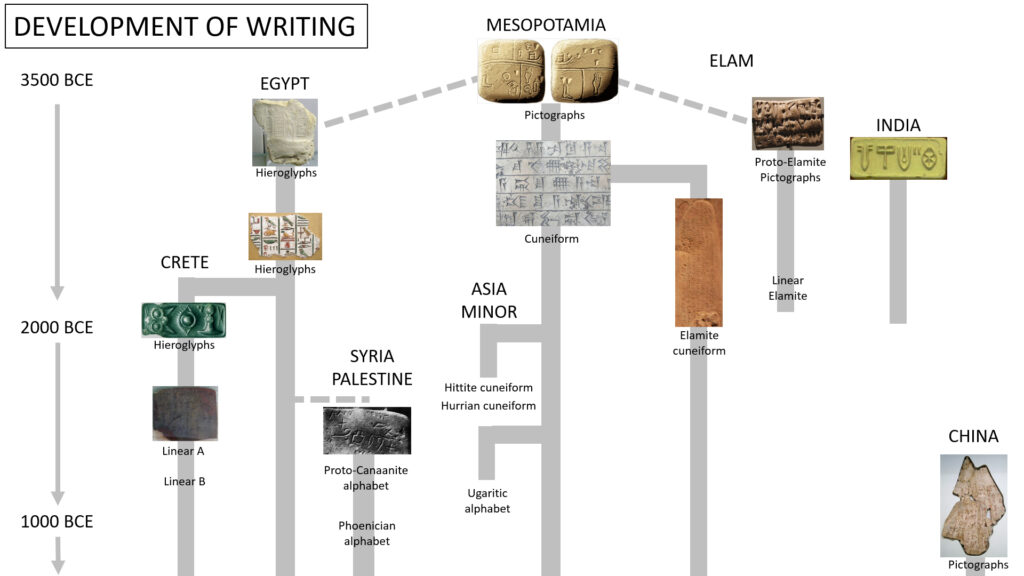
- a third major astrological constellation of the new age of the chart was the square position (tension, competition between Saturn as indicator of governments and stability of tribes and nations in Gemini the sign of language, writing, communication, technology, learning, contacts, exchange, mobility, roads, vehicles and tools with Uranus as indicator of globalization, self-finding, inspiration, rainy seasons, floods, revolution, mutation and inventions in Virgo the sign of the science of agriculture and gardening and of self-protection, adaptation, organisation of work and of human potentials, slavery and medicine.
- the competition between Saturn in Gemini and Uranus in Virgo can so be examined as an explanation of how the factors of multiplication of technological and cultural developments were stimulated by confrontation with pressure, challenges and information from arriving new contacts, and the development of language and mobility.
- the position of Mercury as the sign ruler of Gemini in Taurus explains that the aim of technological and informational development in this era lies in the stabilization of food production, wealth and income and in learning to handle the survival of human civilization.
Level II: Neptune-Pluto “Months” as Sub-Divisions of a full 33.000 years Neptune-Pluto Year or Super Cycle
The first and most important sub-division of a full Neptune-Pluto-Year of appr. 33.000 years is by the 12 signs. The length of these periods varies from ca. 990 years (Pisces) to ca. 4434 years (or possibly even 4929) for the signs Gemini to Libra. These sub-periods may be compared to the twelve 30° “sign months” of the solar year.
For investigation of the history of the human era particularly the sub-periods since the end of the last glacial-age (113.000 BC – 9.700 BCE) are of major interest for an astrological evaluation of the history of humans.
In the current and last Neptune-Pluto year the duration of the stations of the NE-PL conjunctions in each single sign was approximately:
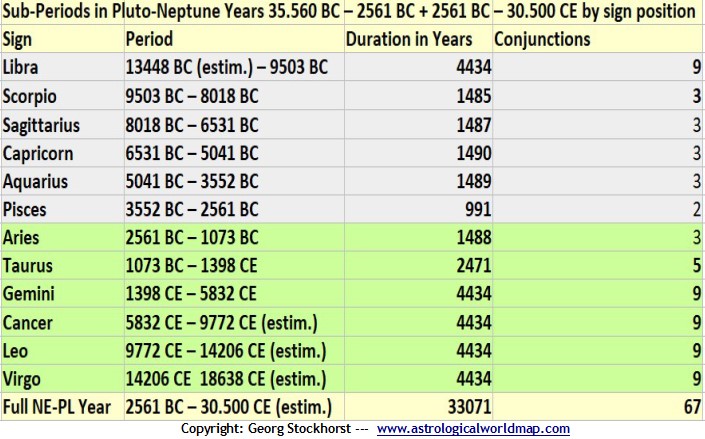
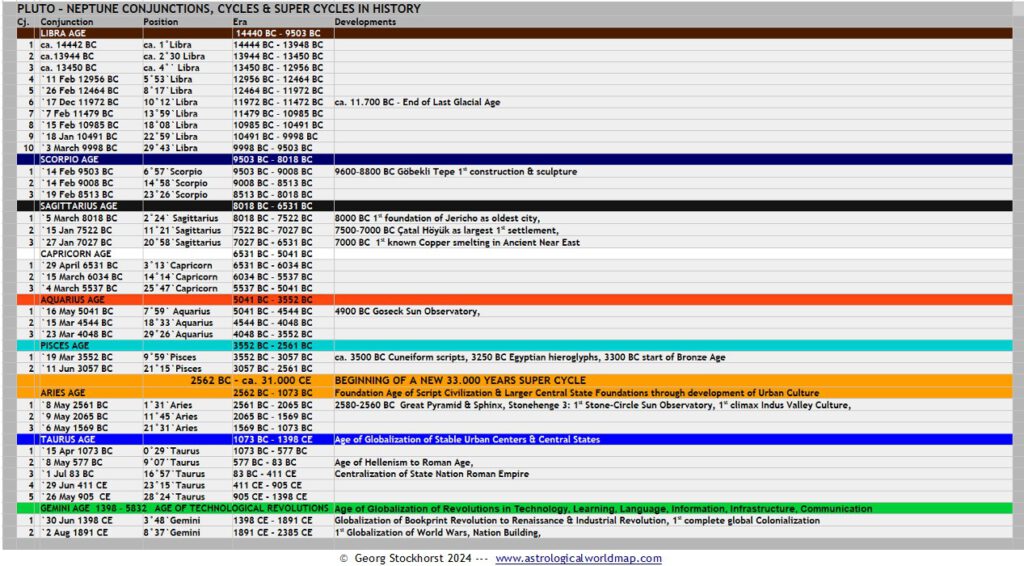
The Birth Chart for the “NE-PL Month” of Technological Revolution between 1398 CE and 5832 CE
- Since the beginning of the current Pluto-Neptune year in 2561 BC human civilization has gone through an ARIES SUB-PERIOD (NE-PL month) from 2561 BC to 1073 BC and a TAURUS SUB-PERIOD from 1073 BC – 1398 CE.
- the perspective opened up through the shift from the Taurus “NE-PL Month” (1073 BC – 1398 CE) to the Gemini “NE-PL Month” (1398 CE – 5832 CE) delivers a highly impressive differentiation between an age of agriculture (Taurus) and an age of technological innovation (Gemini).
- the horoscope for the Neptune-Pluto conjunction of 1398 can so be identified as the initial chart for the “Age of Technological Modernity”
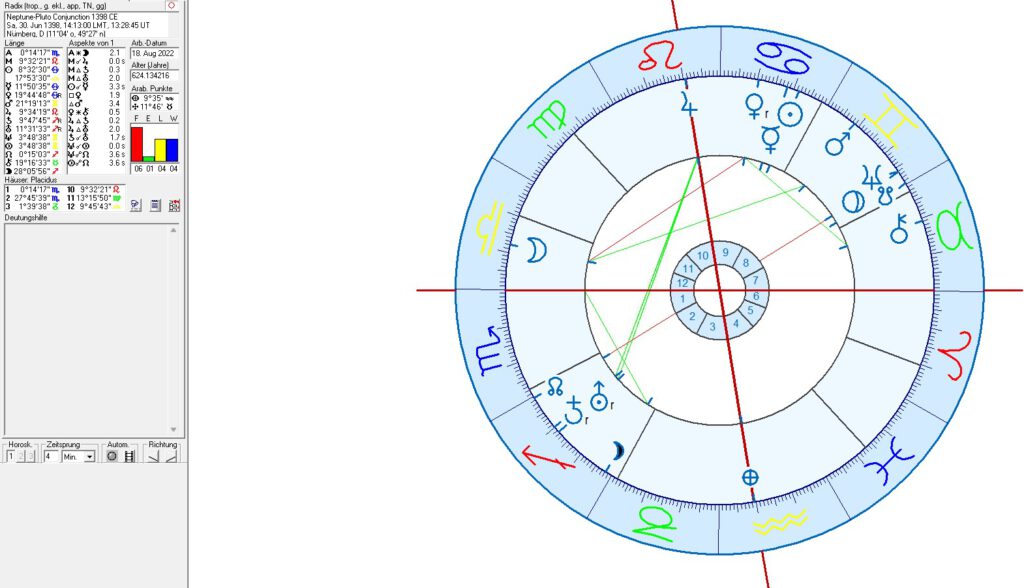
- Important developments that followed the shift of Neptune-Pluto conjunctions from Taurus into Gemini on 30 Jun 1398 were: the European “Renaissance” of technology, science, schooling, learning, informational exchange and mobility, the European discovery and colonization of all continents, the 18th to 20th centuries global Industrial Revolution, the 20th/21st centuries global Digital Revolution, Climate Change and Catastrophe due to human over-population, over-production and over-exploitation of natural resources. Every single one of these developments can clearly be compared to the realms of Gemini.
Level III: Single Neptune-Pluto cycles: the Sub-Division of Neptune-Pluto months into 2 (Pisces) to 9 (Gemini to Libra) subsequent sub-periods in which the conjunction occurs in one sign
Every single period of consecutive Neptune-Pluto conjunctions in one and the same sign (“Neptune-Pluto Months”) can be divided into sub-periods consisting of the single Neptune-Pluto cycles of ca. 495 earth years (+/- 3) between two conjunctions.
The initial chart for the current Neptune-Pluto cycle between 1891 CE and 2385 CE
The current appr. 495 years long sub-sub-period (“Pluto-Neptune week”) of the 33.000 years Neptune-Pluto Year and 4434 years Neptune Month conjunction was initialized by the conjunction of 2 August 1891. This sub-sub-period will remain effective from the conjunction of 2 August 1891 CE until the next conjunction on 30 May 2385 CE.
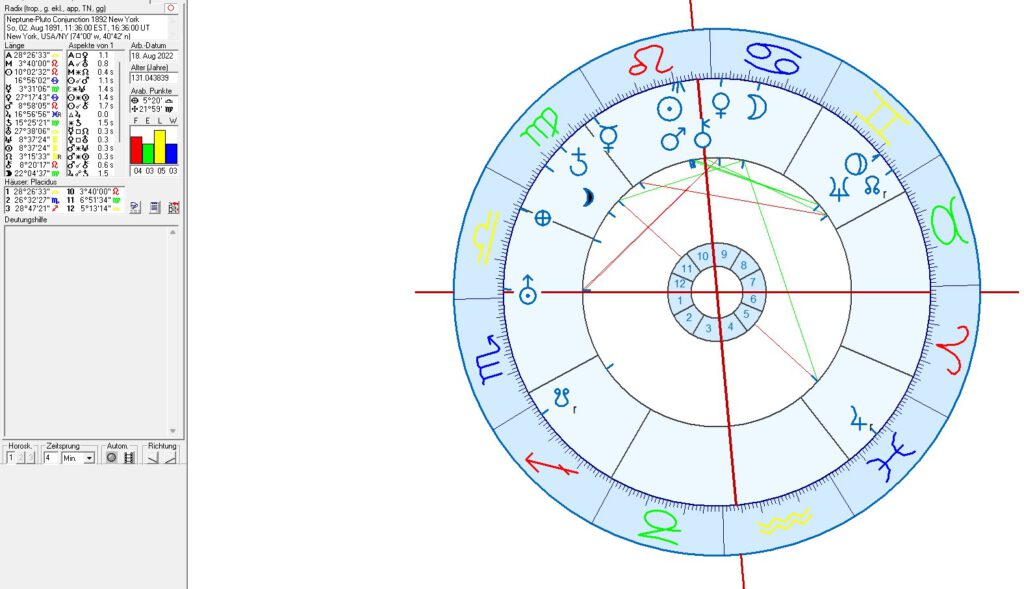
Level IV: the 4 major stations of each Neptune-Pluto cycle
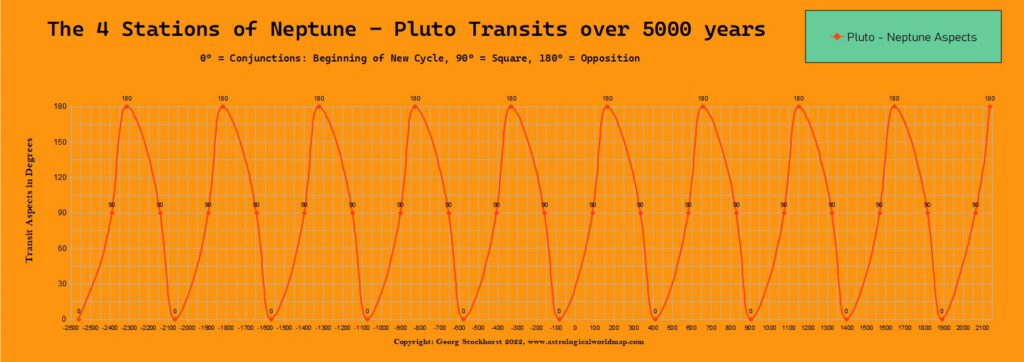
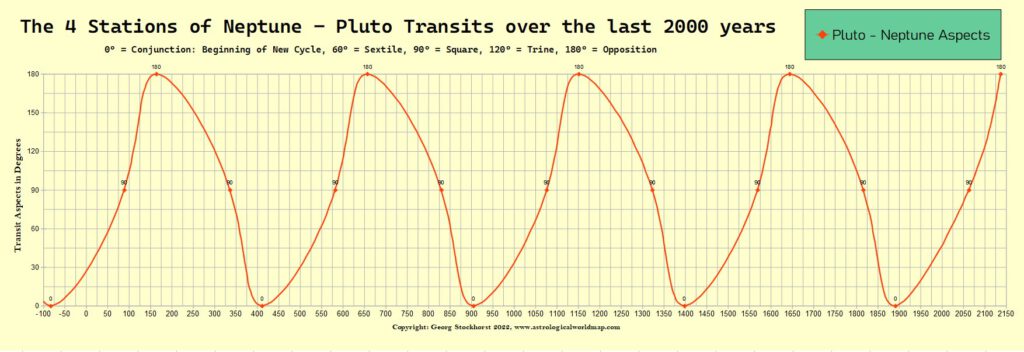
Each 492-496 years period activated by any first conjunction of Pluto and Neptune can be naturally divided into 4 sub-periods:
I — conjunction to rising square: the materialization of the new process
II — rising square to opposition: the process reaches his climax through confrontation
III — opposition to falling/waning square:
IV — falling square to the next 1st conjunction
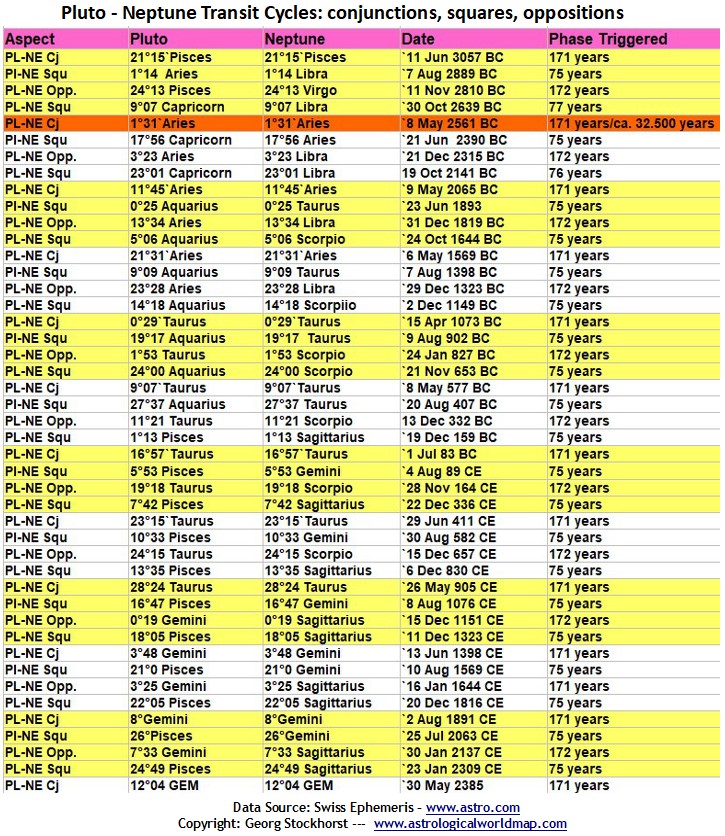
- the period from conjunction to opposition (period of ascension of topics) and from opposition to the next conjunction (period of the descending of issues) are equally long: 247 years.
- therefore the moment of opposition has the quality of a half-time between two Pluto-Neptune conjunctions.
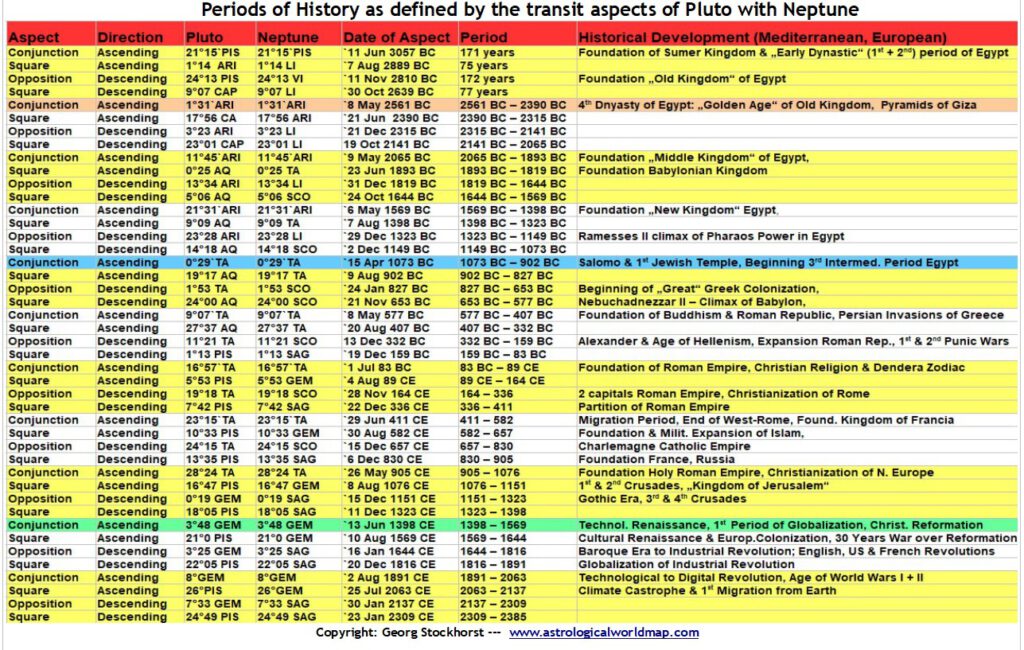
Charts for the 4 sub-periods of the last Neptune-Pluto cycle 1398 CE to 1892 CE
The last Neptune-Pluto cycle (1396-1891) was initiated by the conjunction of the two planets at 3°48` Gemini on 13 June 1398 CE.. It was the 8th conjunction in the current Pluto-Neptune year between 2.561 B.C. and 30.500 CE. which I have defined as the “Age of Civilization”.

Stage 1 the Neptune-Pluto conjunction of 13 June 1398 and the period 1398 to 1569
The chart for the initial Neptune Pluto conjunction of 13 June 1398 CE started the new 496 year cycle between 1398 and 1891 which manifested as the 8th sub-cycle and 8th stage of development of the mundane issues of human civilization since the beginning of the current age in 2561 BCE..

Stage 2: the ascending square of 20 August 1569 and the period 1569 to 1644

Stage 3: the Pluto-Neptune opposition of 16 Jan 1644 and the period 1644 to 1816
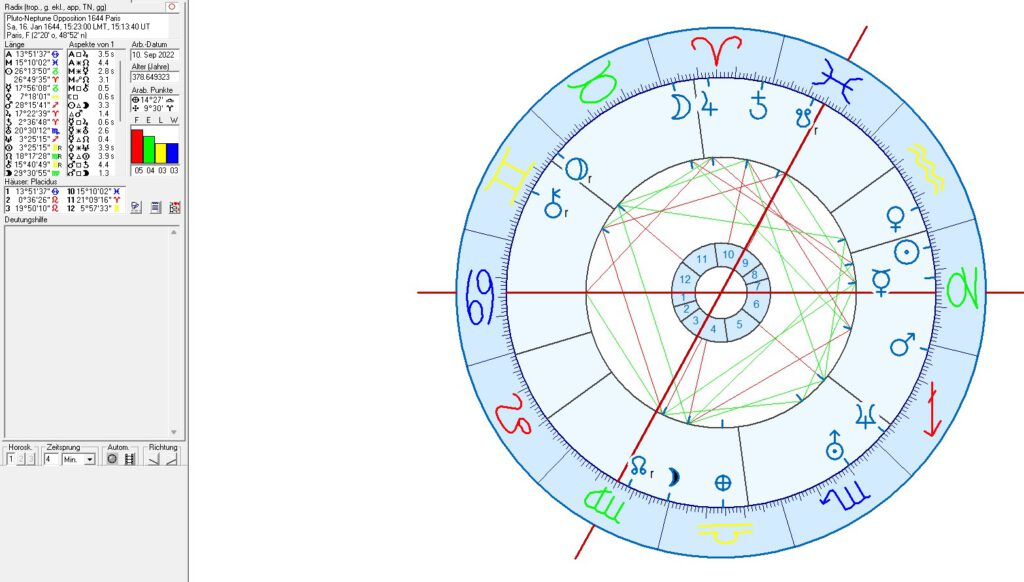
Stage 4: the Pluto-Neptune descending square of 1816 and the period 1816 to 1892

